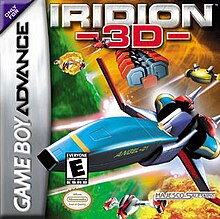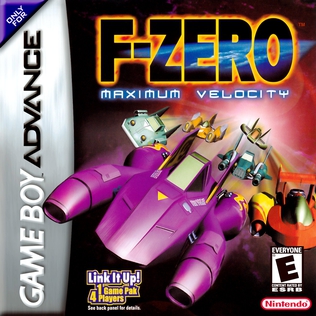
F-Zero: Maximum Velocity is a futuristic racing game developed by NDcube and published by Nintendo as a launch game for the Game Boy Advance. It was released in Japan, North America and Europe in 2001. It was the first F-Zero game released on a handheld game console.
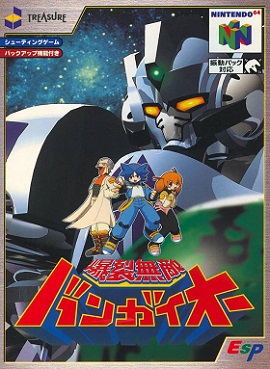
Bangai-O is a multidirectional shooter developed by Treasure and released in 1999 on the Nintendo 64 in Japan. It was ported to the Dreamcast worldwide shortly after with some gameplay changes and updated graphics and audio. The game places the player in control of a weaponized mech that can hover across large stages and fire at enemies all around them. The player must reach the end of each stage and defeat the boss, while avoiding hazards scattered across the map such as enemy mechs and gun turrets.

Castlevania: Circle of the Moon, titled Castlevania in PAL regions, is a 2001 action role-playing game created by Konami for the Game Boy Advance. Published as a launch title in 2001, Circle of the Moon is part of Konami's Castlevania video game series, the premise of which centers on the eternal conflict between the vampire hunters of the Belmont clan and the vampire Dracula. The game sold one million copies worldwide and was acclaimed by critics. The events of its plot were retconned by former Castlevania producer Koji Igarashi, a move which was met with some criticism.

Medal of Honor: Underground is a 2000 first-person shooter video game developed by DreamWorks Interactive and published by Electronic Arts. It is the second installment in the Medal of Honor series and was released for the PlayStation with an adapted port later for the Game Boy Advance.

Silent Scope is an arcade game created in 1999 by Konami. The game puts the player in the shoes of a sniper during a series of terrorist incidents. It is the first in the Silent Scope series.
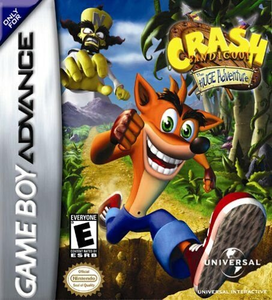
Crash Bandicoot: The Huge Adventure is a 2002 platform game developed by Vicarious Visions and published by Universal Interactive for the Game Boy Advance. It is the seventh installment in the Crash Bandicoot video game series, the first Crash Bandicoot game not to be released on a PlayStation console, and the first Crash Bandicoot game to be released on a handheld console. The game's story centers on a plot to shrink the Earth by the main antagonist, Doctor Neo Cortex, through the use of a gigantic weapon named the "Planetary Minimizer". The protagonist of the story, Crash Bandicoot, must gather Crystals in order to power a device that will return the Earth to its proper size, defeating Doctor Cortex and his minions along the way.

Driver 2 is a 2000 action driving video game and the second installment of the Driver series. It was developed by Reflections Interactive and published by Infogrames for PlayStation. A port to the Game Boy Advance, titled Driver 2 Advance, was released in 2002, developed by Sennari Interactive and released under Infogrames' Atari range of products.

Nanostray is a vertically scrolling shooter for the Nintendo DS. The user takes control of a futuristic spacecraft against a horde of enemies. A sequel, Nanostray 2, was released in 2008.

Ecks vs. Sever is a first-person shooter video game for the Game Boy Advance handheld game console. It was developed by Crawfish Interactive and released in November 2001. The game is based on an early script of the 2002 film Ballistic: Ecks vs. Sever, and is the first video game released before the film it is based on had even begun production. The sequel Ballistic: Ecks vs. Sever was released within a week of the film and follows its plot line more closely than the first game does.

Dave Mirra Freestyle BMX 2 is a sports video game developed by Z-Axis and Full Fat and published by Acclaim Entertainment under their Acclaim Max Sports label. It was released for the PlayStation 2 in August 2001, and in the following months it was ported to the GameCube, Game Boy Advance, and Xbox video game systems. Both the GameCube and Xbox ports featured two extra levels that were not present in the PS2 version.

Gradius Advance is a horizontally scrolling shooter handheld video game developed by Mobile21 and published by Konami in 2001. It was released later in the same month in the United States as Gradius Galaxies and in 2002 in Japan as Gradius Generation. It is the only Gradius title available for the Game Boy Advance. The game's plot is set between Gradius III and Gradius Gaiden. Bacterion was developing a powerful weapon to use against the planet Gradius, but it was destroyed. A few years later it crashed on a planet and the planet gradually changed into a mechanical fortress. The planet Gradius then sent the Vic Viper to stop it.

Army Men Advance is a top-down shooter video game developed by DC Studios and published by the 3DO Company exclusively for Game Boy Advance. Much like Army Men: Sarge's Heroes, the story has General Plastro and his army of tan figurines have decided to take over the world and it is up to Sarge and reporter Vikki Grimm to thwart the conquest. Throughout the game, the player is required to rescue team members, infiltrate tan bases, escape from a jail, investigate an extra terrestrial presence, and retrieve communications equipment. The player can choose to play as either Sarge or Vikki, but the quests for each are identical and once a character has been chosen it is impossible to switch to the other unless the player wants to start again from the first mission.

Bomberman Tournament is a game in the Bomberman series for the GBA. The game contains a multiplayer battle mode between linked Game Boy Advances. The player and up to three others can compete in any of the game's eight multiplayer battle arenas, each of which has its own unique gameplay twist.

Ready 2 Rumble Boxing: Round 2 is a boxing game for the Dreamcast, Nintendo 64, PlayStation, PlayStation 2, and Game Boy Advance. It is the sequel to Ready 2 Rumble Boxing.

GT Advance Championship Racing, known in Japan as Advance GTA, is a racing game developed by MTO and published by THQ. It was a launch title for the Game Boy Advance. The game's sequel, GT Advance 2: Rally Racing, was released on June 30, 2002 in North America.

NHL 2002 is a video game released by EA Sports in 2001. It is the predecessor to NHL 2003. The game's cover man is Pittsburgh Penguins superstar and owner Mario Lemieux, who had just made a comeback after being retired for three and a half years. It was the first installment of the NHL series to be released on Xbox.

NASCAR Heat 2002, sometimes mislabeled as NASCAR Heat, is a NASCAR video game produced by Infogrames for the Xbox, PlayStation 2, and Game Boy Advance consoles. It is the successor to the NASCAR Heat game, and the predecessor to NASCAR: Dirt to Daytona. NASCAR Heat 2002 can have 24 racers (PS2) and 43 released on June 18, 2001 on the PS2, and has 19 official NASCAR tracks. The Xbox version was released on November 15, 2001 and the Game Boy Advance version was released on May 6, 2002.

Iridion II is a scrolling shooter video game developed by Shin'en Multimedia and published by Majesco Entertainment and Vivendi Universal Games in North America and PAL regions respectively for the Game Boy Advance handheld video game console. It is the sequel to Iridion 3D although it is played from a different perspective.

High Heat Major League Baseball 2002, also known as High Heat Baseball 2002, is a video game released in 2001, and is the fourth game in the High Heat Major League Baseball video game series. Then-Montreal Expos right fielder Vladimir Guerrero is featured on the cover. The game was released in March 2001 for Microsoft Windows, PlayStation, and PlayStation 2, followed by a Game Boy Advance port in September 2001. A Game Boy Color version was also in development but was cancelled.
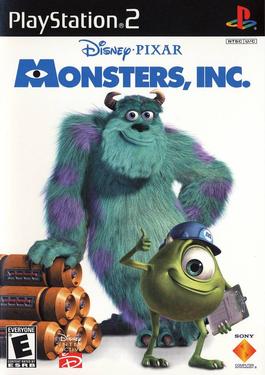
Monsters, Inc. is a 2001 platform game based on the 2001 film of the same name released for Game Boy Color, Game Boy Advance, and PlayStation 2. The Game Boy Color and Game Boy Advance versions of the game were released in October 26, 2001 in North America and in February 1, 2002 in Europe. The PlayStation 2 version was only released in North America in March 20, 2002. The Game Boy Advance version was also released on a Twin Pack cartridge bundled with Finding Nemo in 2005.
